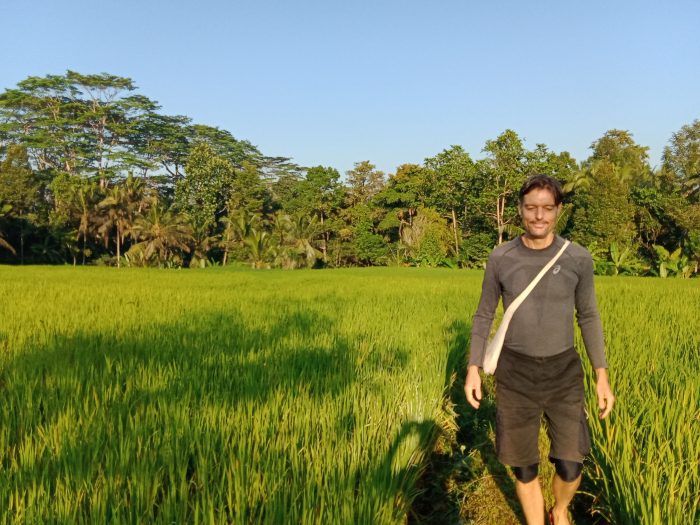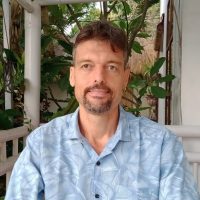Ode to the Rice Field Walks of Bali
A few months ago, I suffered a relatively serious shoulder injury during the course of my Ashtanga yoga practice.
I felt something shift inside the joint, as though it had been wrenched, and at once, I knew it wasn’t good. The MRI (magnetic resonance imaging) confirmed I would not be back on the mat any time soon.
Yoga had hitherto been a pivotal part of my life, and I relied on it for a sense of general well-being. Two hours of sweating on my mat would cleanse my body and clear my mind, the better to focus on my day. I knew that without a substitute for yoga, my mental and emotional balance, not to mention my physical fitness, would suffer. And so, I reverted to the oldest form of exercise known to man: walking.
Here in Bali, where I am currently blessed to find myself, I walk mostly among the rice fields—mainly at daybreak or in the early evening. Aside from the cooler temperatures at these times, the light is exquisite, and when the sun is low on the horizon, the trees look as though they have been stenciled into a painter’s skies—cinnabar, magenta, amber, or glowing orange.
It is impossible not to wonder at the beauty of nature here, but in case I should somehow manage to become lost in thought, rice fields have the added advantage that one can walk barefoot.
And, as Carl Jung pointed out (during a visit to India), “When you walk with naked feet, how can you forget the earth?”
Walking does not give me the same intensity as yoga asana, but I find that, strangely, it gives me more serenity. I would describe it as contemplative rather than meditative—I never find the complete stillness and inner silence that sitting meditation sometimes brings, but my thoughts slow and soften, and, when I walk alone at sunrise, they seem to follow their own choreography—like gentle shadows dancing to the rhythm of my step.
It seems, too, that movement—the mere fact of being in motion under my own steam—produces inspired, creative ideas.
In Twilight of the Idols, Nietzsche boldly stated, “All truly great thoughts are conceived while walking.”
Because of its rhythm—and, in my case, the gentle vibrations with each footfall—I find walking an excellent way to shift energy also. Any heaviness, somber mood, concerns, or worries seem to dissipate as I tread the path.
The French philosopher, Rousseau, was an inveterate walker, who loved to celebrate the “view of the countryside,” and explains the inner state walking induced in him: “Never have I thought so much, existed and lived so much, been so much myself (…) as in [the journeys] I made alone and on foot.”
Here, he touches upon another point that strongly resonates with me: the value of walking alone. I once walked for weeks across the Pyrenean mountains in the south of France, many summers ago, and people would often ask me how I did it.
“I could never walk on my own,” some would say, “I need company.”
“I have my own company,” I would have liked to answer, “and it is enough.”
When my legs feel strong, and my lungs breathe freely, when exertion carries me through peaceful natural landscapes, the question of boredom or loneliness does not arise.
Perhaps, this is why walking can be so therapeutic. It is not just soothing and invigorating, it can help us go within and face our shadows, and emerge healed and unburdened.
In his beautiful book, Nature Cure, Richard Mabey describes poignantly how walking helped him recover from a long and deep depression. Of course, if walking is to help us find peace within ourselves and the world around us, we must persevere, but the beauty of walking is that in my experience—it builds its own momentum to the extent that it becomes almost self-sustaining and mildly compulsive. At times, I even find it hypnotic and, often, lulled by an unvarying pace and the clockwork movement of my limbs, I realize I am moving mechanically, and feel I could walk forever toward the horizon, like Forrest Gump.
I experienced this pull that walking exercises over the walker on the Camino de Santiago, when I went from Le Puy en Velay in France to Santiago de Compostella in northern Spain. For the first few days, I walked the way, but by and by, it is the way that carried me. And the Camino was not the first time I experienced the magic of long-distance walking.
I had previously walked the 100 or so miles of the Cotswold Way in England, and been inspired to write the following poem:
The Walker
Stray straw strewn across hard-trodden earth
The path, studded with rogue rocks, scrapes underfoot
Rough steps, heaving breaths, mere moments in intangible time…
I walk
Sunlight, like amber honey on the grass stems
The breeze, awash with fragrances, of earth and air—coarse, sweet, pungent,
ethereal macrocosm of scents…
I breathe
Through the slow hours the sun moves
Beneath playful clouds a solitary man strides
By and by the Way and I merge…
Pain and doubt, flow and exhilaration mingle
Birdsong—a wood pigeon grants me right of way…
Or is it Rite of Passage?
I am











Read 5 comments and reply